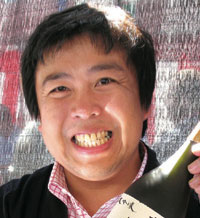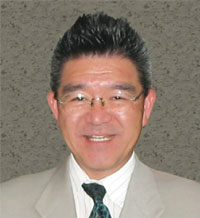Sake Nation “A new way to promote Japanese sake combines a live-stream (two-dimensional) event with an in-person tasting (three-dimensional) event: Pa
By Kosuke Kuji
A new way to promote Japanese sake fusing a 2-dimensional live-stream with a 3-dimensional in-person event requires us real-world sake brewers to first jump into the 2-dimensional world of Vtubers (virtual YouTubers).
Vtubers and sake brewers entered the same world via Zoom to participate in a virtual sake brewery tour and sake tasting event.
Viewers who enjoy sake in the 3-dimensional real world and others who enjoy interacting in the 2-dimensional digital world discussed Ginjo together in the same screen, indicative of endless possibilities for future collaboration.
Further, this collaboration with Vtubers produced an illustration by the Vtubers used on the sake label, printed onto sake cups to create limited-edition merchandise for this event. These merchandise were a huge hit, sold out on the e-commerce platform mercari, thanks to online viewers who never purchased Japanese sake before. The 2-dimesional world fused with the 3-dimensional world for Vtubers, who enjoyed a live event from the comfort of their home as they enjoyed sake during this exclusive collaboration.
Lastly, the “Enjoy Ginjo Fair” was held at the Hotel Metropolitan Tokyo Ikebukuro in late September. Here, Vtuber Yuzuru Himesaki participated by video in the digital 2-dimensional world, while sake breweries participated in the 3-dimensional real world, and performed the ritual of breaking open a ceremonial sake barrel. Here, the 2-dimensional digital world fused into this 3-dimensional in-person event.
In this way, traditional Japanese industries like sake breweries jumped into a new world using the latest cutting-edge IT technology, a truly fruitful collaboration and experience.
I hope this fusion of two worlds of different dimensions attracts new Japanese sake fans to revitalize the domestic consumption of sake in Japan, showing continued decline.
酒豪大陸「二次元と三次元の融合による新たな日本酒の道 その3」
2次元と3次元の融合による新たな日本酒の道ですが、今回は私達リアルな蔵元がまずはVチューバ―の皆さんの世界(2次元)に飛び込むことから始まりました。
Zoomを使ってVチューバ―の皆さんと蔵元が同じ世界に入り、バーチャル蔵見学と酒の会を実施しました。3次元でいつも楽しんでいる人も、2次元が大好きな人も同じ画面の中で吟醸酒を語りある姿は本当に未来を感じました。
さらに、Vチューバ―の皆さんとコラボしてVチューバ―の絵をラベルにし、さらにはおちょこなどにも印刷して、今回限定の商品も作成しました。これも大当たりで、今まで日本酒を買ったことなどなかった2次元大好きな方々がネットでメルカリショップスから全て購入していただき、自宅で大好きなVチューバ―のライブを見ながら飲むというすごい2次元と3次元の融合がおきました。
最後は、9月末に池袋のメトロポリタンホテルで開催した“エンジョイ吟醸酒フェア”。こちらには2次元からVチューバ―の姫咲ゆずるさんに映像で登場していただき、3次元からは蔵元が登場し、一緒に鏡開きを行いました。今度は3次元の世界で2次元と3次元の融合をすることが出来ました。
このように、日本酒という伝統産業の世界でも、今の最先端のIT技術を使う事で新たな世界に飛び出せる事が出来ました。本当に素晴らしい体験、経験でした。
新たな日本酒ファンを獲得して、減り続ける日本の日本酒消費を立て直していきたいと思います。
A new way to promote Japanese sake fusing a 2-dimensional live-stream with a 3-dimensional in-person event requires us real-world sake brewers to first jump into the 2-dimensional world of Vtubers (virtual YouTubers).
Vtubers and sake brewers entered the same world via Zoom to participate in a virtual sake brewery tour and sake tasting event.
Viewers who enjoy sake in the 3-dimensional real world and others who enjoy interacting in the 2-dimensional digital world discussed Ginjo together in the same screen, indicative of endless possibilities for future collaboration.
Further, this collaboration with Vtubers produced an illustration by the Vtubers used on the sake label, printed onto sake cups to create limited-edition merchandise for this event. These merchandise were a huge hit, sold out on the e-commerce platform mercari, thanks to online viewers who never purchased Japanese sake before. The 2-dimesional world fused with the 3-dimensional world for Vtubers, who enjoyed a live event from the comfort of their home as they enjoyed sake during this exclusive collaboration.
Lastly, the “Enjoy Ginjo Fair” was held at the Hotel Metropolitan Tokyo Ikebukuro in late September. Here, Vtuber Yuzuru Himesaki participated by video in the digital 2-dimensional world, while sake breweries participated in the 3-dimensional real world, and performed the ritual of breaking open a ceremonial sake barrel. Here, the 2-dimensional digital world fused into this 3-dimensional in-person event.
In this way, traditional Japanese industries like sake breweries jumped into a new world using the latest cutting-edge IT technology, a truly fruitful collaboration and experience.
I hope this fusion of two worlds of different dimensions attracts new Japanese sake fans to revitalize the domestic consumption of sake in Japan, showing continued decline.
酒豪大陸「二次元と三次元の融合による新たな日本酒の道 その3」
2次元と3次元の融合による新たな日本酒の道ですが、今回は私達リアルな蔵元がまずはVチューバ―の皆さんの世界(2次元)に飛び込むことから始まりました。
Zoomを使ってVチューバ―の皆さんと蔵元が同じ世界に入り、バーチャル蔵見学と酒の会を実施しました。3次元でいつも楽しんでいる人も、2次元が大好きな人も同じ画面の中で吟醸酒を語りある姿は本当に未来を感じました。
さらに、Vチューバ―の皆さんとコラボしてVチューバ―の絵をラベルにし、さらにはおちょこなどにも印刷して、今回限定の商品も作成しました。これも大当たりで、今まで日本酒を買ったことなどなかった2次元大好きな方々がネットでメルカリショップスから全て購入していただき、自宅で大好きなVチューバ―のライブを見ながら飲むというすごい2次元と3次元の融合がおきました。
最後は、9月末に池袋のメトロポリタンホテルで開催した“エンジョイ吟醸酒フェア”。こちらには2次元からVチューバ―の姫咲ゆずるさんに映像で登場していただき、3次元からは蔵元が登場し、一緒に鏡開きを行いました。今度は3次元の世界で2次元と3次元の融合をすることが出来ました。
このように、日本酒という伝統産業の世界でも、今の最先端のIT技術を使う事で新たな世界に飛び出せる事が出来ました。本当に素晴らしい体験、経験でした。
新たな日本酒ファンを獲得して、減り続ける日本の日本酒消費を立て直していきたいと思います。




